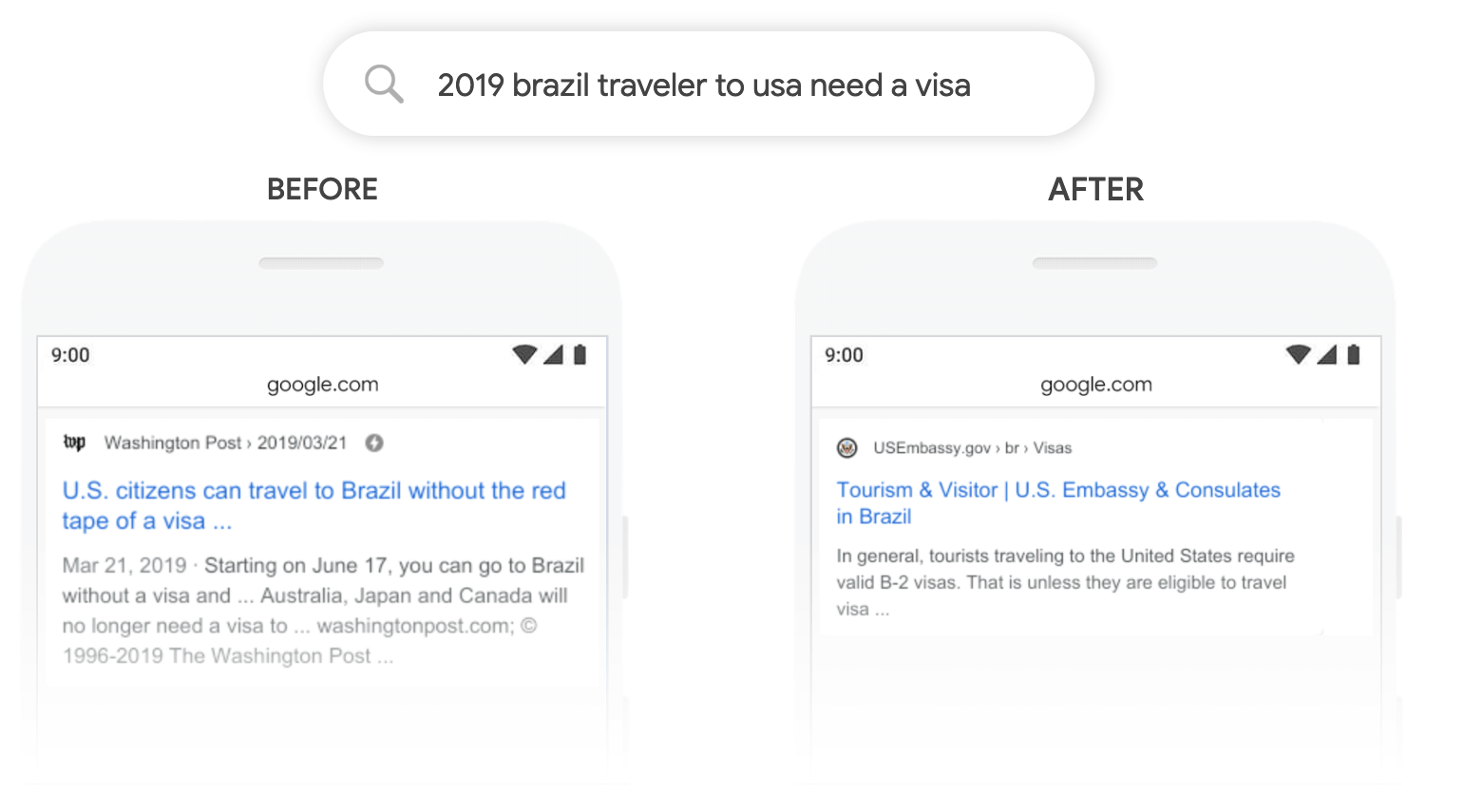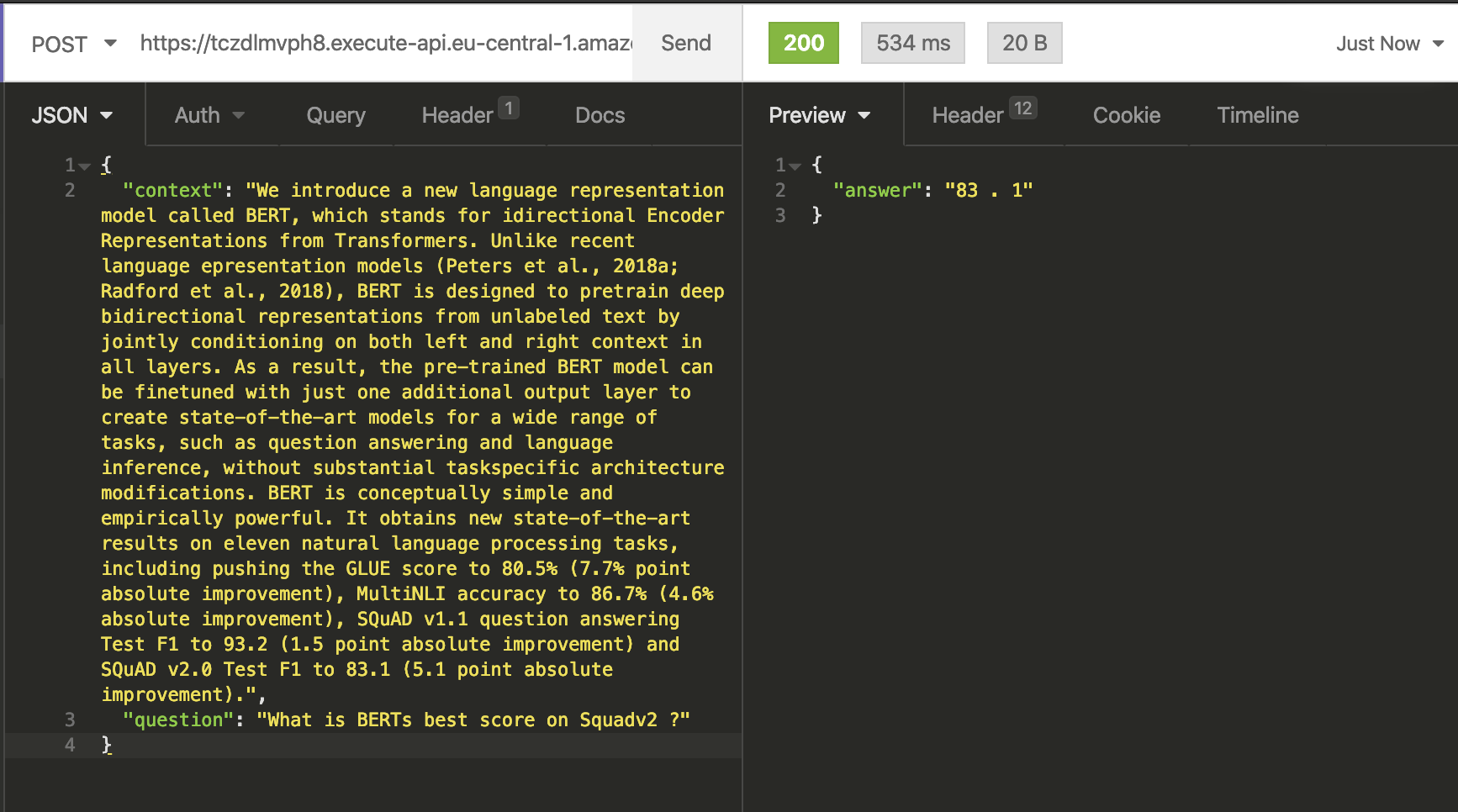Serverless BERT with HuggingFace and AWS Lambda
"Serverless" and "BERT" are two topics that strongly influenced the world of computing. Serverless architecture allows us to provide dynamically scale-in and -out the software without managing and provisioning computing power. It allows us, developers, to focus on our applications.
BERT is probably the most known NLP model out there. You can say it changed the way we work with textual data and what we can learn from it. "BERT will help [Google] Search [achieve a] better understand[ing] one in 10 searches". BERT and its fellow friends RoBERTa, GPT-2, ALBERT, and T5 will drive business and business ideas in the next few years and will change/disrupt business areas like the internet once did.
 search language understanding BERT
search language understanding BERT
Imagine the business value you achieve combining these two together. But BERT is not the easiest machine learning model to be deployed in a serverless architecture. BERT is quite big and needs quite some computing power. Most tutorials you find online demonstrate how to deploy BERT in "easy" environments like a VM with 16GB of memory and 4 CPUs.
I will show you how to leverage the benefits of serverless architectures and deploy a BERT Question-Answering API in a serverless environment. We are going to use the Transformers library by HuggingFace, the Serverless Framework, and AWS Lambda.
Transformer Library by Huggingface

The Transformers library provides state-of-the-art machine learning architectures like BERT, GPT-2, RoBERTa, XLM, DistilBert, XLNet, T5 for Natural Language Understanding (NLU) and Natural Language Generation (NLG). It also provides thousands of pre-trained models in 100+ different languages and is deeply interoperability between PyTorch & TensorFlow 2.0. It enables developers to fine-tune machine learning models for different NLP-tasks like text classification, sentiment analysis, question-answering, or text generation.
AWS Lambda
AWS Lambda is a serverless computing service that lets you run code without managing servers. It executes your code only when required and scales automatically, from a few requests per day to thousands per second. You only pay for the compute time you consume – there is no charge when your code is not running.

Serverless Framework
The Serverless Framework helps us develop and deploy AWS Lambda functions. It’s a CLI that offers structure, automation, and best practices right out of the box. It also allows us to focus on building sophisticated, event-driven, serverless architectures, comprised of functions and events.

If you aren’t familiar or haven’t set up the Serverless Framework, take a look at this quick-start with the Serverless Framework.
Tutorial
Before we get started, make sure you have the Serverless Framework configured and set up. You also need a working Docker environment. A Docker environment is used to build our own python runtime, which we deploy to AWS Lambda. Furthermore, you need access to an AWS Account to create an S3 Bucket and the AWS Lambda function.
In the tutorial, we are going to build a Question-Answering API with a pre-trained BERT model. The idea is we send a
context (small paragraph) and a question to the lambda function, which will respond with the answer to the question.
As this guide is not about building a model, we will use a pre-built version, that I created using distilbert. You can
check the colab notebook here.
context = """We introduce a new language representation model called BERT, which stands for
Bidirectional Encoder Representations from Transformers. Unlike recent language
representation models (Peters et al., 2018a; Radford et al., 2018), BERT is
designed to pretrain deep bidirectional representations from unlabeled text by
jointly conditioning on both left and right context in all layers. As a result,
the pre-trained BERT model can be finetuned with just one additional output
layer to create state-of-the-art models for a wide range of tasks, such as
question answering and language inference, without substantial taskspecific
architecture modifications. BERT is conceptually simple and empirically
powerful. It obtains new state-of-the-art results on eleven natural language
processing tasks, including pushing the GLUE score to 80.5% (7.7% point absolute
improvement), MultiNLI accuracy to 86.7% (4.6% absolute improvement), SQuAD v1.1
question answering Test F1 to 93.2 (1.5 point absolute improvement) and SQuAD
v2.0 Test F1 to 83.1 (5.1 point absolute improvement)."""
question_one = "What is BERTs best score on Squadv2 ?"
# 83 . 1
question_two = "What does the 'B' in BERT stand for?"
# 'bidirectional encoder representations from transformers'Before we start, I want to say that we're not gonna go into detail this time. If you want to understand more about how to use Deep Learning in AWS Lambda I suggest you check out my other articles:
- Scaling Machine Learning from ZERO to HERO
- How to Set Up a CI/CD Pipeline for AWS Lambda With GitHub Actions and Serverless
The architecture we are building will look like this.

What are we going to do:
- create a Python Lambda function with the Serverless Framework
- create an S3 Bucket and upload our model
- Configure the
serverless.yaml, addtransformersas a dependency and set up an API Gateway for inference - add the
BERTmodel from the colab notebook to our function - deploy & test the function
You can find everything we are doing in this GitHub repository and the colab notebook.
Create a Python Lambda function
First, we create our AWS Lambda function by using the Serverless CLI with the aws-python3 template.
serverless create --template aws-python3 --path serverless-bertThis CLI command will create a new directory containing a handler.py, .gitignore and serverless.yaml file. The
handler.py contains some basic boilerplate code.
import json
def hello(event, context):
body = {
"message": "Go Serverless v1.0! Your function executed successfully!",
"input": event
}
response = {
"statusCode": 200,
"body": json.dumps(body)
}
return responseAdd transformers as a dependency
The Serverless Framework created almost anything we need, except for the requirements.txt. We create the
requirements.txt by hand and add the following dependencies.
https://download.pytorch.org/whl/cpu/torch-1.5.0%2Bcpu-cp38-cp38-linux_x86_64.whl
transformers==2.10Create an S3 Bucket and upload the model
AWS S3 and Pytorch provide a unique way of working with machine learning models which are bigger than 250MB. Why 250 MB? The size of the Lambda function is limited to 250MB unzipped.
But S3 allows files to be loaded directly from S3 into memory. In our function, we are going to load our model
squad-distilbert from S3 into memory and reading it from memory as a buffer in Pytorch.
If you run the
colab notebook
it will create a file called squad-distilbert.tar.gz, which includes our model.
For creating an S3 Bucket you can either create one using the management console or with this command.
aws s3api create-bucket --bucket bucket-name --region eu-central-1 --create-bucket-configuration LocationConstraint=eu-central-1After we created the bucket we can upload our model. You can do it either manually or using the provided python script.
import boto3
def upload_model(model_path='', s3_bucket='', key_prefix='', aws_profile='default'):
s3 = boto3.session.Session(profile_name=aws_profile)
client = s3.client('s3')
client.upload_file(model_path, s3_bucket, key_prefix)Configuring the serverless.yaml
This time I provided the complete serverless.yamlfor us. If you want to know what each section is used for, I suggest
you check out
Scaling Machine Learning from ZERO to HERO. In
this article, I went through each configuration and explain the usage of them.
service: serverless-bert
provider:
name: aws
runtime: python3.8
region: eu-central-1
timeout: 60
iamRoleStatements:
- Effect: 'Allow'
Action:
- s3:getObject
Resource: arn:aws:s3:::<your-S3-Bucket>/<key_prefix>/*
custom:
pythonRequirements:
dockerizePip: true
zip: true
slim: true
strip: false
noDeploy:
- docutils
- jmespath
- pip
- python-dateutil
- setuptools
- six
- tensorboard
useStaticCache: true
useDownloadCache: true
cacheLocation: './cache'
package:
individually: false
exclude:
- package.json
- package-log.json
- node_modules/**
- cache/**
- test/**
- __pycache__/**
- .pytest_cache/**
- model/pytorch_model.bin
- raw/**
- .vscode/**
- .ipynb_checkpoints/**
functions:
predict_answer:
handler: handler.predict_answer
memorySize: 3008
timeout: 60
events:
- http:
path: ask
method: post
cors: true
plugins:
- serverless-python-requirementsAdd the BERT model from the colab notebook to our function
A typical transformers model consists of a pytorch_model.bin, config.json, special_tokens_map.json,
tokenizer_config.json, and vocab.txt. Thepytorch_model.bin has already been extracted and uploaded to S3.
We are going to add config.json, special_tokens_map.json, tokenizer_config.json, and vocab.txt directly into our
Lambda function because they are only a few KB in size. Therefore we create a model directory in our lambda function.
If this sounds complicated, check out the GitHub repository.
The next step is to create a model.py in the model/ directory that holds our model class ServerlessModel.
from transformers import AutoModelForQuestionAnswering, AutoTokenizer, AutoConfig
import torch
import boto3
import os
import tarfile
import io
import base64
import json
import re
s3 = boto3.client('s3')
class ServerlessModel:
def __init__(self, model_path=None, s3_bucket=None, file_prefix=None):
self.model, self.tokenizer = self.from_pretrained(
model_path, s3_bucket, file_prefix)
def from_pretrained(self, model_path: str, s3_bucket: str, file_prefix: str):
model = self.load_model_from_s3(model_path, s3_bucket, file_prefix)
tokenizer = self.load_tokenizer(model_path)
return model, tokenizer
def load_model_from_s3(self, model_path: str, s3_bucket: str, file_prefix: str):
if model_path and s3_bucket and file_prefix:
obj = s3.get_object(Bucket=s3_bucket, Key=file_prefix)
bytestream = io.BytesIO(obj['Body'].read())
tar = tarfile.open(fileobj=bytestream, mode="r:gz")
config = AutoConfig.from_pretrained(f'{model_path}/config.json')
for member in tar.getmembers():
if member.name.endswith(".bin"):
f = tar.extractfile(member)
state = torch.load(io.BytesIO(f.read()))
model = AutoModelForQuestionAnswering.from_pretrained(
pretrained_model_name_or_path=None, state_dict=state, config=config)
return model
else:
raise KeyError('No S3 Bucket and Key Prefix provided')
def load_tokenizer(self, model_path: str):
tokenizer = AutoTokenizer.from_pretrained(model_path)
return tokenizer
def encode(self, question, context):
encoded = self.tokenizer.encode_plus(question, context)
return encoded["input_ids"], encoded["attention_mask"]
def decode(self, token):
answer_tokens = self.tokenizer.convert_ids_to_tokens(
token, skip_special_tokens=True)
return self.tokenizer.convert_tokens_to_string(answer_tokens)
def predict(self, question, context):
input_ids, attention_mask = self.encode(question, context)
start_scores, end_scores = self.model(torch.tensor(
[input_ids]), attention_mask=torch.tensor([attention_mask]))
ans_tokens = input_ids[torch.argmax(
start_scores): torch.argmax(end_scores)+1]
answer = self.decode(ans_tokens)
return answerIn the handler.py we create an instance of our ServerlessModel and can use the predict function to get our answer.
try:
import unzip_requirements
except ImportError:
pass
from model.model import ServerlessModel
import json
model = ServerlessModel('./model', <s3_bucket>, <file_prefix>)
def predict_answer(event, context):
try:
body = json.loads(event['body'])
answer = model.predict(body['question'], body['context'])
return {
"statusCode": 200,
"headers": {
'Content-Type': 'application/json',
'Access-Control-Allow-Origin': '*',
"Access-Control-Allow-Credentials": True
},
"body": json.dumps({'answer': answer})
}
except Exception as e:
return {
"statusCode": 500,
"headers": {
'Content-Type': 'application/json',
'Access-Control-Allow-Origin': '*',
"Access-Control-Allow-Credentials": True
},
"body": json.dumps({"error": repr(e)})
}Deploy & Test the function
In order to deploy the function you only have to run serverless deploy.
After this process is done we should see something like this.

Test and Outcome
To test our Lambda function we can use Insomnia, Postman, or any other REST client. Just add a JSON with a context and
a question to the body of your request. Let´s try it with our example from the colab notebook.
{
"context": "We introduce a new language representation model called BERT, which stands for idirectional Encoder Representations from Transformers. Unlike recent language epresentation models (Peters et al., 2018a; Radford et al., 2018), BERT is designed to pretrain deep bidirectional representations from unlabeled text by jointly conditioning on both left and right context in all layers. As a result, the pre-trained BERT model can be finetuned with just one additional output layer to create state-of-the-art models for a wide range of tasks, such as question answering and language inference, without substantial taskspecific architecture modifications. BERT is conceptually simple and empirically powerful. It obtains new state-of-the-art results on eleven natural language processing tasks, including pushing the GLUE score to 80.5% (7.7% point absolute improvement), MultiNLI accuracy to 86.7% (4.6% absolute improvement), SQuAD v1.1 question answering Test F1 to 93.2 (1.5 point absolute improvement) and SQuAD v2.0 Test F1 to 83.1 (5.1 point absolute improvement).",
"question": "What is BERTs best score on Squadv2 ?"
}
Our ServerlessModel answered our question correctly with 83.1. Also, you can see the complete request took 319ms
with a lambda execution time of around 530ms. To be honest, this is pretty fast.
The best thing is, our BERT model automatically scales up if there are several incoming requests! It scales up to thousands of parallel requests without any worries.
If you rebuild this, you have to be careful that the first request could take a while. First off, the Lambda is unzipping and installing our dependencies and then downloading the model from S3.
Thanks for reading. You can find the GitHub repository with the complete code here and the colab notebook here.
Thanks for reading. If you have any questions, feel free to contact me or comment this article. You can also connect with me on Twitter or LinkedIn.